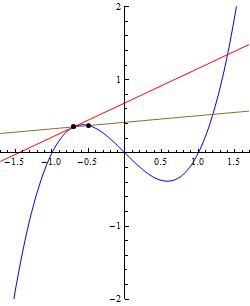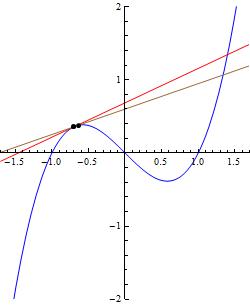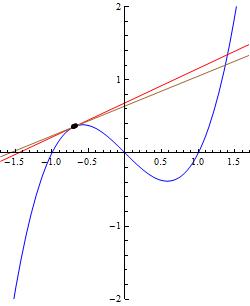Revised 2017-04-08 Introduction to this website website TOC website index blog Back to top of Understanding Math chapter
When mathematicians consider a mathematical object, they are typically interested in two different aspects of it:
I want a conceptual understanding of the object.
Proofs can have a conceptual side and a computational side too.
Here is a simple example that shows the distinction between concept and computation. This identity \[{{a}^{2}}-{{b}^{2}}=(a-b)(a+b)\] holds for all real numbers. (In fact it holds in any commutative ring.)
This proof shows an explicit series of steps that verify the identity using basic laws of algebra: \[\begin{align*} (a-b)(a+b)&= (a-b)a+(a-b)b \;\;\; \text{distributive law} \\ &= {{a}^{2}}-ba+ab-{{b}^{2}} \;\;\; \text{distributive law applied twice} \\ &= {{a}^{2}}-ab+ab-{{b}^{2}} \;\;\; \text{commutative law} \\ &= {{a}^{2}}+0-{{b}^{2}} \\ &= {{a}^{2}}-{{b}^{2}} \end{align*}\]
These laws hold in every commutative ring, so the identity holds in every commutative ring.
This diagram shows why the identity is true geometrically (for $b\le a$).

Boxes 1 and 2 are congruent, so have the same area. Therefore the area of boxes 1 and 3 is the same as the area of boxes 2 and 3. But the first one has area $(a+b)(a-b)$ and the second one has area $a^2-b^2$, so necessarily $a^2-b^2=(a+b)(a-b)$.
This conceptual proof requires no algebraic laws at all. On the other hand, it is not easy to see how to generalize it to a commutative ring. Think about drawing a picture that shows that\[{{a}^{2}}-{{b}^{2}}=(a-b)(a+b)\] for all complex numbers $a$ and $b$.
The idea of "conceptual proof" depends on your experience. If you are not familiar with basic geometric facts, the preceding geometric proof may not be conceptual!
Here is another example that shows how "conceptual" depends on what you know.
For all real numbers $x$ $y$, and $z$, if $x\le z$, then either $x\le y$ or $y\le z$.
This is a standard trick for proving that "$P$ or $Q$", namely prove directly that if $P$ is false then $Q$ has to be true.
If $x\leq y$ is not true, then it must be true that $y\lt x$. We are given that $x\leq z$, so now we know that $y\lt x$ and $x\leq z$. It follows from that fact that the ordering of the reals is transitive that $y\leq z$.
The number $y$ has to be in one of three intervals in this picture of (part of) the real line. (The left interval goes off to infinity to the left and the right interval goes off to infinity to the right. The middle interval has finite length.)

If y is in the left interval or the middle interval, then $y\le z$. If it is in the middle or right interval, then $x\le y$.
If you have some experience with mathematical logic, you might react to the logical proof (as I did) this way:
The statement in the theorem is nothing but the contrapositive of the transitive law!
When I realized that, I felt that I had acquired a new insight, so I consider this to be a conceptual proof. The geometric proof gives you a different conceptual insight.
Most students learn these facts in elementary school, but not necessarily with the terminology given here.
This theorem states a property of the GCD of two integers. It is the reason why the Euclidean Algorithm works.
Let $m$ and $n$ be positive integers, and let $r$ be the remainder when $m$ is divided by $n$. Then \[\text{GCD} (m,n)= \text{GCD} (n,r)\]
The proof starts by proving a Lemma.
Lemma: Let $m$ and $n$ be positive integers and let $r$ be the remainder when $m$ is divided by $n$. Then an integer $d$ divides both $m$ and $n$ if and only if it divides both $n$ and $r$.
The derivative of a function $f$ is another function $f'$ whose value at $a$ is the slope of the tangent line to $f$ at $a$. This picture shows the tangent line to $y=x^3-x$ at the point $x=-0.7$.

The slope of the tangent line at $x=-0.7$ is about $0.47$. You could in fact calculate that value, to one decimal place anyway, by drawing a very careful picture of the graph of $y=x^3-x$, positioning the tangent line by eye and then measuring the run and rise with a ruler.
You can get a better estimate by looking at the secant lines that go through the point of tangency and one other nearby point. They are shown below for $x=-0.7.$ The other point in each case is $x=-0.7+h$ for $h=0.2,\, 0.1,\,0.06,\,0.02,\,0.01$ in that order.





The slope of the secant line is \[\frac{f(x+h)-f(x)}{x-(x-h)}=\frac{f(x+h)-f(x)}{h}\] when $h$ is small. For example, for $x=-0.7$ and $h=0.01$ the value is about $0.4491$, and when $h=0.001$ it is $0.467901$.
The trouble with getting the exact value of the slope, which is when $h=0$, is that it looks like you must divide by zero. However, a miracle occurs when $f(x)=x^3-x$: The formula for the slope simplifies to $3x^2+3xh+h^2-1$, so the limit when $h\to0$ is $3x^2-1$. So now we have a formula for the derivative function for $x^3-x$. If you have taken a little calculus, you may know that we can always get a formula for the derivative of a polynomial this way, and (with extra cleverness in some cases) for the derivatives of most other calculus-type functions.
This example shows how mathematicians (in this case in the seventeenth century) started from the naive or pictorial idea of the derivative as giving the slope of the tangent line and created calculations that allowed us to have a formula for the derivative of many functions.
There is more detail about this in my blog post The power of being naive, which has diagrams you can manipulate with your mouse.
When $f(x)=x^3-x$, \[\begin{align} \dfrac{f(x+h)-f(x)}{h}&=\dfrac{(x+h)^3-x-h-x^3+x}{h}\\ &=\dfrac{x^3+3x^2h+3xh^2+h^3-x-h-x^3+x}{h}\\ &=\dfrac{3x^2h+3xh^2+h^3-h}{h}\\ &=3x^2+3xh+h^2-1\end{align}\]
Note that the terms that don't contain $h$ disappear in the third step. This always happens with any polynomial. Isn't that a miracle?
This work is licensed under a Creative Commons Attribution-ShareAlike 2.5 License.